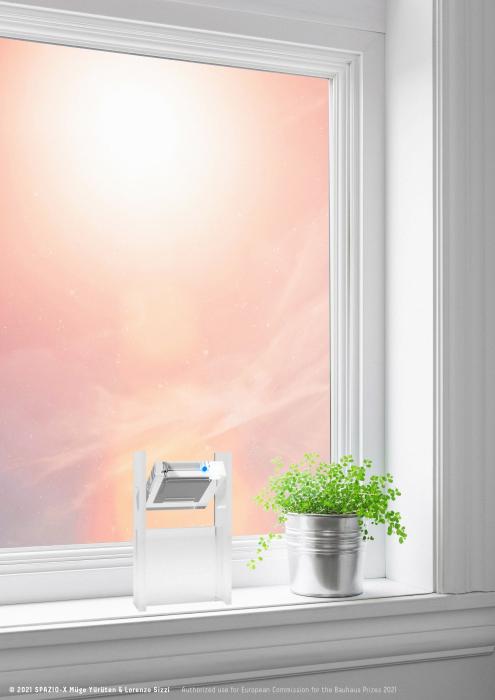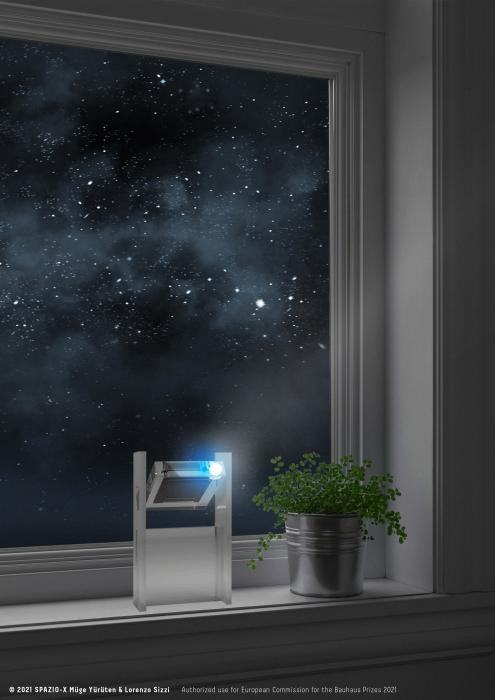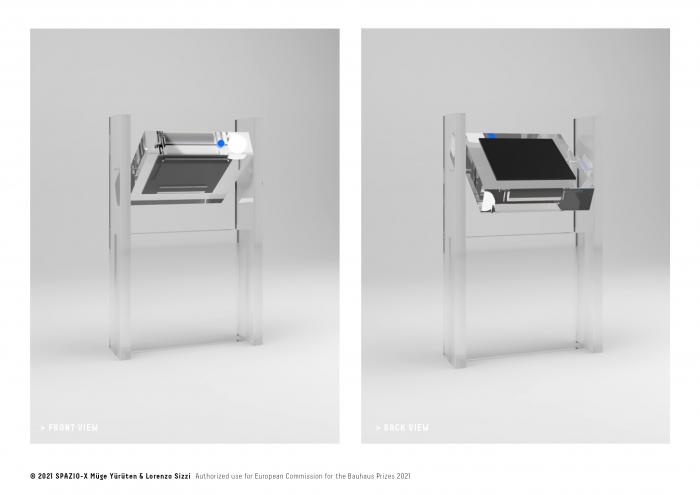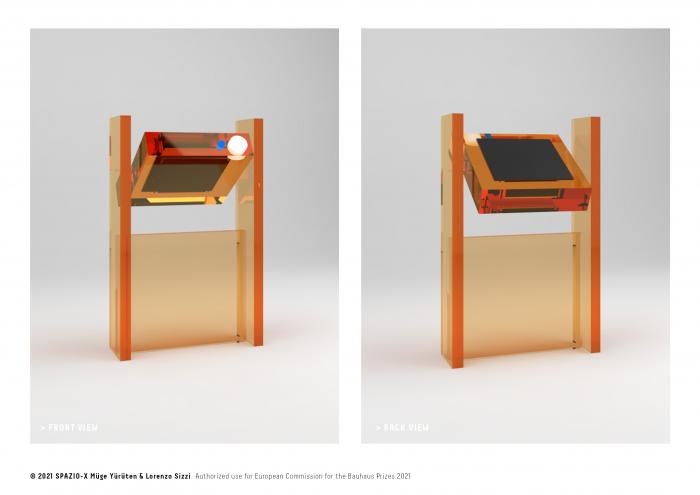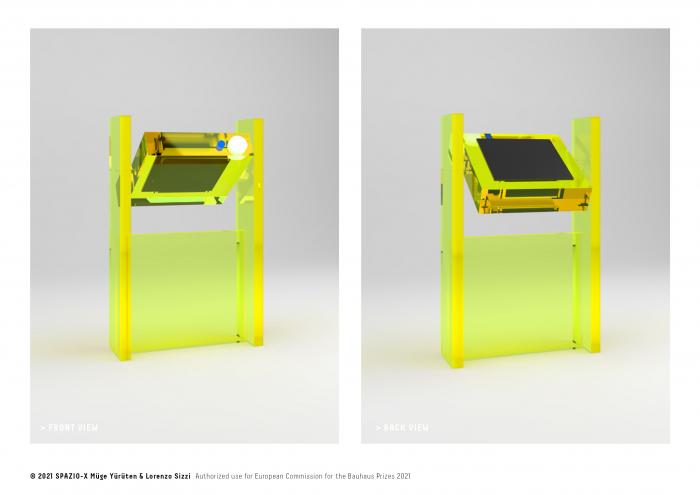I. SUMMARY INFORMATION
Project
269390
Status
Submitted
Award category
Products and life style
You want to submit
NEW EUROPEAN BAUHAUS RISING STARS : concepts or ideas submitted by young talents (aged 30 or less)
Project title
HOME: Solar-Powered Lamp
Full concept/idea title
Solar Energy Routine for Domestic Environments
Description
Questioning the comprehension of the place we call home, HOME is a transdisciplinary project investigating climate change’s causes, effects, and solutions for sustainable future development. The project proposes a solar-powered LED lamp designed for everyday use, to introduce solar technology in the domestic routine of contemporary dwellings, raising awareness and fostering the future use of clean sources to cut emissions endangering human life on our home planet, the Earth.
Where is your concept/idea being developed or intended to be implemented in the EU?
Italy
Lombardia
Via Privata Treviso 16
45.50229981
9.23521598
Milano
20127
II. DESCRIPTION OF THE PROJECT
Please provide a summary of your concept/ idea
What is home? According to the literal definition, home is the place where one lives permanently especially as a member of a family or household, but when we think about where we live — our home addresses — we often ignore several lines in the format. As result of collective human achievements, we are discovering more about the universe and our place in it. This cosmic consciousness allows us to enrich the formula of our addresses with additional lines that are common to all humankind: Earth, Solar System, Milky Way Galaxy, Local Galactic Group, Virgo Supercluster, Observable Universe, and furthermore still to discover.
On 14 February 1990, when Voyager 1 the spacecraft was departing our planetary neighborhood, Carl Sagan asked NASA to turn it around for one last look at our home planet. As a result, the iconic image of our planet was taken and titled Pale Blue Dot by Carl Sagan. “That's here. That's home. That's us. On it everyone you love, everyone you know, everyone you ever heard of, every human being who ever was, lived out their lives... We are just a mote of dust suspended in a sunbeam. For us, we’re the mote of dust: That’s here. That’s home.’’ (Sagan, 1994)
It is our responsibility to preserve the life that has graced our small world through a development that meets the fundamental necessities without compromising the needs of future generations.
Questioning the comprehension of the place we call home, HOME is a transdisciplinary project that considers the causes of increasing climate change and proposes a line of action based on awareness and collective effort to ensure sustainable development. By identifying in the use of clean and renewable energy a tool to mitigate the global warming emergency, the project’s outcome is a solar-powered lamp designed for everyday use. The eventual goal is to introduce solar technology in the domestic routine of contemporary dwellings, fostering clean energy as a valid alternative to traditional CO2 emitting sources.
Please give information about the key objectives of your concept/idea in terms of sustainability and how these would be met
Considering the rise of planet Earth’s surface average temperature, this project declines the term sustainability in its environmental meaning, facing an emergency endangering contemporary and future generations. Global warming is the result of uncontrolled anthropogenic activity leading to climate change, and every human is responsible to gain awareness of its alarming effects on the natural patterns, and on how to positively contributing.
Despite reducing harmful emissions as soon as possible would substantially cut the impact of climate change, 80% of the world’s energy comes from non-renewable sources (International Energy Agency, 2021). HOME focuses on the remaining 20% of the energy that is clean, identifying in the sun a renewable and universally available source, and in solar technology the easiest way to reduce CO2 emissions on a domestic everyday use basis.
Through the design of a domestic and practical object such as a solar LED lamp, the project proposes to introduce a clean and consolidated technology within the contemporary household's environment as part of a daily routine committed to reducing emissions. Despite energy consumption and emissions related to lighting represents a small percentage of the whole balance of a dwelling, getting the users comfortable with solar technology through a small object of everyday use carries the ambitious goal to foster future decisions — such as the installation of a solar system powering the whole house — based on an aware understanding of the possibilities for renewable and sustainable sources.
Please give information about the key objectives of your concept/idea in terms of aesthetics and quality of experience beyond functionality and how these would be met
The solar-powered lamp HOME is a lighting device designed to be an everyday experience of use. It consists of a case containing the technological components, mounted on a light transparent structure, being a high-quality addition to the domestic environment. The device’s first peculiarity regards the type of lights and their possibilities of usage. The system is composed of a high-performative solar panel transmitting the energy from the sun to a rechargeable battery powering two different and independent LEDs: the first one is a warm-white light, while the second one is a symbolic blue light representing the Pale Blue Dot, our planet in the deepness of universe.
The 82x82mm case — an explicit reference to the 8’20” that light needs to reach the Earth from the Sun — is mounted on a small transparent structure, designed to be portable, and to fit on a windowsill or a small night table. The case is connected to the structure via a 360° pivoting hinge, thus allowing easily orient the solar panel mounted on the back of the case to catch solar rays and to freely address the lights during usage time. The position of the solar panel and the LEDs has been combined to allow a zero-maintenance use mode when the lamp is located close to a window: during the day — also in absence of direct sun — the daylight recharges the device, allowing from 5 to 10 hours of clean energy based on intensity and battery capacity.
Please give information about the key objectives of your concept/idea in terms of inclusion and how these would be been met
Nowadays, solar technology is well-consolidated and whether it is common for large applications in the built environment, being often a compulsory requirement for new constructions, it is still stranger to most uses in terms of daily life routine. Many of the human-scaled solar-powered devices currently on the market are designed for outdoor applications such as camping or garden lighting, where electricity is not available. HOME’s outcome is an innovative object designed for domestic use, working in every context — both in the presence or absence of a grid — to be a conscious high-quality alternative to the traditional existing LED lamp types.
The project is the outcome of a transdisciplinary approach combining science, culture, product design, and technology for sustainable development. Requiring only basic knowledge to be engineered, the solar device HOME proposes everyday access to clean energy, and by relying upon an affordable technology, the target of addressed users is potentially unlimited. This symbolic domestic product bears the ambitious goal to establish a dialogue with its users; not only allowing the users to familiarize with an effective and innovative way of using clean energy but also to evoke the uniqueness of our home planet Earth — Pale Blue Dot.
As Carl Sagan reflected on Pale Blue Dot; “The Earth is the only world known so far to harbor life. There is nowhere else, at least in the near future, to which our species could migrate. There is perhaps no better demonstration of the folly of human conceits than this distant image of our tiny world. To me, it underscores our responsibility to deal more kindly with one another, and to preserve and cherish the pale blue dot, the only home we've ever known.”
Please explain the innovative character of your concept/ idea
This project focuses on the responsibility to take action and positively contributing to the improvement of the ever-changing society, identifying in familiarizing with clean and renewable energy the first possible step to mitigate the global warming emergency. Throughout the years we have witnessed the evolution of the light bulb, from incandescent to LED. Following this constant improvement in terms of energy consumption and performances, the project’s purpose is to combine an advanced artificial light system with a solar panel — clean energy catalyzer — looking at the lighting industry as a powerful channel to share and amplify the vision of sustainable development for the future generations.
HOME’s outcome is a solar-powered LED lamp made by a technological kit enclosed in an 82x82mm case and mounted on a transparent structure intended to amplify its applications within domestic environments. It is an innovation in terms of habits, introducing in the routine of its users a solar cycle rhythm, where few hours of natural light exposition correspond to few hours of clean artificial light. The eventual ambitious goal is to display the quality of renewable solar energy through a common and affordable object of everyday use, raising awareness and fostering the future use of clean sources to cut emissions endangering human life on earth. A collective effort to ensure sustainable development for the next generations.
Please detail the plans you have for the further development, promotion and/or implementation of your concept/idea, with a particular attention to the initiatives to be taken before May 2022
Questioning the comprehension of the place where we live, HOME is a transdisciplinary project investigating climate change’s causes, effects, and solutions for sustainable future development. The project culminates in the conceptual and executive design of a feasible and affordable solar-powered LED lamp, to be engineered and produced following a six-to-ten months plan to be carried out between 2021 and 2022 under the designers’ conduction.
The first step to undertake is the prototyping phase according to European regulations and high-quality technological standards. As the design consists of two main components — a technological kit and a structural part — two companies will be initially entrusted for testing&producing the prototypes that will then be assembled under the constant designers’ supervision. Following the prototyping phase, a communication campaign will be launched, promoting the project among online and printed architecture and design media. At the same time, a website will be developed as integral parts of the project HOME, gathering the information on the functioning of the lamp and showing data researched during the conceptual phase. The last step, to be achieved by the beginning of 2022, is the production of solar-powered lamp HOME along with all the packaging and logistic arrangements, to be inserted on the market through a dedicated online platform, thus allowing eventual next production steps in the future.
III. UPLOAD PICTURES
IV. VALIDATION
By ticking this box, you declare that all the information provided in this form is factually correct, that the proposed concept/idea has not been proposed for the New European Bauhaus Rising Stars Awards more than once in the same category.
Yes
